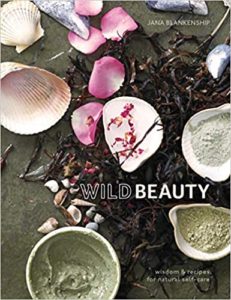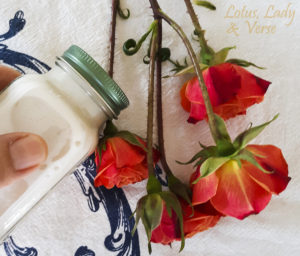A Notion of Scents and Wild Beauty
Does the mixture of Orange and Rose essential oils result in a delicious aroma? Undoubtedly, yes! Orange and Rose are the top and heart notes of a four-oil aromatic combination called Venus Rose Blend from Wild Beauty, a book about nature and you. The signature scent by Jana Blankenship creates an alluring aroma, one that you apply often to feel calmer, more joyful, even a bit sensuous.
What notions do you have for a more resinous combination of scents, like Frankincense and a Citrus oil? Or a very bright, inspiring blend starring Clary Sage and Rosemary?
If you’re looking to find your compass with aromas and help with their direction, specifically with aromatic self-care and herbs, a recent handbook I review here is my absolute hands-down first choice.
 Wild Beauty. Wisdom & Recipes for Natural Self-Care. Jana Blankenship, 2019. Published by Ten Speed Press.
Wild Beauty. Wisdom & Recipes for Natural Self-Care. Jana Blankenship, 2019. Published by Ten Speed Press.
A Handbook on Wild Beauty
The author’s brand, Captain Blankenship, first appeared in San Francisco in 2009. Over the decade plus since its founding, its products have represented Jana’s esthetic and message. Her message centers on connecting with wild beauty, rewilding our self-care, and so importantly, untangling from a reliance on harmful ingredients.
Wild Beauty is a collection of knowledge, how-tos and instructions for an inspired change of pace in your self-care routine. It’s a true handbook in the sense of a guidebook or introduction to the subjects of self-care and nature. Wild Beauty is an open invitation to Captain Blankenship’s wheelhouse, with recipes you make at home.
Connecting you to the wild beauty of natural elements, the author’s chapter on aromas begins your passage on this delightful journey. Start here to acquire your natural and nature-centered vision with your sense of smell as your guide. Next, skin and hair recipes target specific issues. Finally, the author reveals some delicious ways to enjoy the height of a season in juices, drinks, elixirs, teas.
Wild Beauty offers ideas on self-care from a perspective that’s shared by advocates of clean beauty and those who choose natural and do-it-yourself products over purchased ones. Could this nature-centered point of view be yours as well?
The question to ask may be, “Why do I continue to purchase self-care products that don’t necessarily fit my approach to life?”
Self-Made Self-Care
 What I like about the presentation in Wild Beauty is the main ideas are centered on delight. The book opens with explanations, and soon turns to recipes using aromas—how to construct alluringly beautiful blends for your own version of wild beauty.
What I like about the presentation in Wild Beauty is the main ideas are centered on delight. The book opens with explanations, and soon turns to recipes using aromas—how to construct alluringly beautiful blends for your own version of wild beauty.
Then in her chapter, “Pursuing Wild Beauty” you’ll find ingredients and their uses explained. First all, she describes the positively natural ones, and only after these, the ones we’d best steer clear of. Sidestepping these might be easy anyway, once you’ve decided to make your own self-care products at home.
I was charmed by one of the recipes, “Milk & Honey Shampoo” and made it myself (see illustration), following the author’s instructions. With a combination of milk and honey, I couldn’t go wrong. And it smells really heavenly. What I hadn’t imagined was how sleek and healthy my mane feels afterwards! Once mixed together the ingredients should stay vital for about 1 month in dark and cool storage. I like this ½ cup of shampoo so much it may last about two weeks!
But even if you’re not making your own, you’ll review the names of synthetic substances and chemicals you’ve probably seen listed—they’re not easy to find in small quantities—but were not aware of their nature-disruptive qualities.
Whether you make your own beauty products or not, your self-care and lifestyle choices do show in plain sight. What’s less obvious is the pleasure of crafting your own. And yet, what’s that glow you’ve acquired? It must be from something special, right?
Beauty and Self-Care
Vitality generates beauty, and beauty is supported by vitality. This cycle is a product of self-care.
Blankenship’s recipes include a range of self-care products: cleansing, masking, toning, moisturizing for both skin and hair. Her advice is to work with a few simple ingredients, ones whose qualities are proven, including emollients, also skin-cleansing, skin-tightening, hair-strengthening, and sun-bracing qualities. Examples include tropical butters (shea), healing oils (rosehip seed, etc.), and vitalizing extracts (witch hazel, sea weed, etc.). These ingredients are available in the marketplace, and widely found in health-food stores.
To personalize your potion, put together a blend of essential oils that the author recommends. Then you’ll be on your way with nary a wistful twinge for your old preservative-laden skin routines.
Usually crafted of high-quality ingredients, these self-care products can be quite rich. So use a little, often. Don’t wait, on a vague idea of “saving” it but use immediately, while vitality is high.
The Wild Connection
In my view, the term “wild beauty” calls to mind a dazzling, hypnotizing relationship of humans and nature. Do you agree? When you see them, the book’s cover images and striking photographs are evocative of childhood memories of looking for treasures at the water’s edge. To illustrate this, Blankenship alludes to childhood and nature in her own story.
It’s a story that resonates with me, because I think, we aspire to find our center “in nature”. Even from our position in a world entranced by technology, we still want a strong association with nature. Perhaps to us “nature” symbolizes an anchor in these turbulent times. Jana Blankenship’s theme of nature and nurture aligns nature’s aromas and ingredients with knowledge about how they positively affect you.
Notes:
See Jana Blankenship’s website, Captain Blankenship, here.
Clean beauty is a term used to denote cosmetics that may have been made from organic and locally-sourced ingredients, without the use of preservatives, etc. See more explanation on Environmental Working Group’s website, or here, at Credo Beauty.



